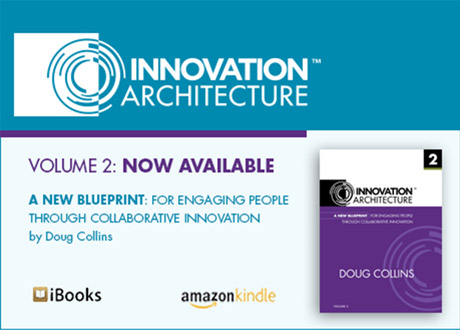By: Doug Collins
For two years our columnist Doug Collins has shared with us his exploration of the practice of collaborative innovation. Today, at this anniversary, we announce the release of volume 2 of his Innovation Architecture series, an exciting and deeply thought-provoking book whose cover is depicted in the headline graphic for this article. Hence, this week, Doug reflects on his contributions that resonated most with readers and shares a few thoughts about what inspired each.
Karin Wall, editor of Innovation Management, e-mailed me two years ago. Her enquiry: Would I share my insight from my work “at the coalface” with people who were embracing the practice of collaborative innovation as a means to transform their organizations beyond the new normal of scarcity dictated by the global recession?
I said “yes.” The idea intrigued me. I was in fact learning a lot as I picked at my rich seam of anthracite.
In time I became adept at drafting 1000 words while tucked by the window of the Boeing 737 taking me home from a client visit. Working at the coalface with them did, as Karin hoped, keep me honest and my writing grounded. Clients make excellent muses.
Fast forward two years and, for a bi-weekly column, 50 articles. Which have resonated—and why?
The Top 10
Innovation Management ranks the top 10 articles in my column, as follows, by page views. I add, anecdotally, that these articles generated buzz in the social media realm. A positive correlation between page views and deeper forms of engagement likely exists.
- How to Combine Innovation with Lean and Six Sigma
- The Persuasive Innovator: Influencing People to Collaborate
- Applying Collaborative Innovation to Agile Software Development
- Why HR and Finance will Love Collaborative Innovation
- A Blueprint for Effective Collaborative Innovation
- PowerPoint Makes us Stupid: Never Mind the Slides, Here’s the World Café
- Engagement Is the ROI on the Front End of Innovation
- Making Collaborative Innovation Stick
- Foment Your Culture of Innovation
- Ascend Your Innovation Plateau: Think Leadership
Observation: Practitioners Practice
Three of the top five articles—lean, agile, and human resources and finance—speak directly to practitioner scenarios. Engaged practitioners, seeking mastery, value ways in which they can explore new approaches and refine their methods.
Lean practitioners seek ways to innovate on intent: True North. They seek ways to innovate on moving from the AS IS to the TO BE states for the value stream. Collaborative innovation can serve as a useful way to engage the larger audience on seeing the whole, particularly when the Gemba walk spans continents. Agile practitioners likewise seek ways for their self-forming and self-governing teams to innovate on their charter and on end user scenarios that drive requirements definition. Here, too, collaboration innovation can serve as a useful way to engage the larger audience of end users, beyond those in the room, particularly when the bulk of end users do not work in close physical proximity down the hall or across the street. The wisdom of the crowd counteracts groupthink.
Lastly, the people in human resources and finance pursue practices where innovation can play a role. I find the human resources scenario intriguing, in particular. Human resources leaders seek innovation to improve core processes such as recruitment, training, and internal communications. At the same time and in a more strategic vein, human resources leaders seek ways to revisit the idea of identifying high-potential employees in the Digital Age. High potential moves from the “chosen few,” selected in silken mandarin fashion, to potentially anyone anywhere in the organization, based on the crowd’s perception of the quality of the ideas and the leadership they express in pursuing their ideas to concept. The practice of collaborative innovation is transformative in this regard. Transparency precedes meritocracy.
Human resources becomes both a practitioner and, in observing how others in the organization pursue the practice, the catalysts for identifying talent in arguably more realistic, valuable ways (figure 1).
Figure 1: collaborative innovation reveals a person’s interests and competencies
Finance is not too far behind in finding ways to fund this new generation of leaders. I predict that internally focused crowd funding becomes the norm—Kickstarter for employees.
Lastly by way of observation, I suspect that people who have mastered one practice—lean, for example—are relatively fearless in embracing a second. That is, each practice, whether wedded to a discipline such as lean or agile or a function such as human resources or finance, demands a level of mastery and competency. Achieving proficiency in one domain opens the mind to achieving proficiency in another.
Observation: A Deeper Dive
Six of the remaining ten articles dive more deeply into the practice of collaborative innovation, proper. I have found that being able to tell one’s story on a page, with a simple visual, makes all the difference in the world. This thought, which I developed through many, many client engagements, led to the creation of what became the article, “A Blueprint for Effective Collaborative Innovation.”
I have since made the blueprint the capstone for the Innovation Architecture series. Why? It works, it works, it works. The blueprint works as a way for practitioners to capture their thoughts. It works, too, as a way to tell their story in a cohesive, compelling way. To this end, Volume 2 of Innovation Architecture includes a set of downloadable, printable worksheets that practitioners can use with their own sponsors and community members. Please see the appendix.
Observation: Still Stupid after All These Years
Lastly, I indulged in imagining myself as a pilgrim on the quixotic quest to eliminate PowerPoint as the pro forma means of business discourse. The popularity of the article, “PowerPoint Makes us Stupid: Never Mind the Slides, Here’s the World Café,” indicates to me that others have gathered the same wool in idle moments.
The dietitian tells us that we are what we eat. The practitioner tells us that we are what we do. People who spend their days noodling on slides are as far away from the practice of collaborative innovation as they can possibly be. Commit to telling your story in more productive ways. Practice what you preach. Draw a picture instead. Shake someone’s hand. The design thinking community does quite well with Post-It Notes® and white boards.
Write If You Get Work
…to the extent that engagement and transparency define the Digital Age and to the extent that the Digital Age has just started, the journey has just begun.
I owe Karin Wall a lot. The discipline of writing this column has caused me to more fully explore what my clients and I have been experiencing as, together, we pursue the practice of collaborative innovation from, “How might we foment a culture of innovation?” to “Is this practice a good idea for this organization?” to “What critical question might we pose?” to “How might we commit to pursuing the resulting ideas as a group?”
Engagement and transparency have been the early, first fruits of our labor on the practice. And, to the extent that engagement and transparency define the Digital Age and to the extent that the Digital Age has just started, the journey has just begun.
I have high hopes for organizations who continue to explore the possibilities that the practice of collaborative innovation can offer them. I see its pursuit as a viable way for organizations to navigate their way forward in the Digital Age for the simple reason that I have seen the practice deliver transformative value for them to date. At the coalface I see most notably their leadership quotient rising as more people come out of the woodwork to embrace the practice.
Pick axe in hand, I myself plan to write more articles. Why not? The seam is rich and extends for miles.
In this spirit I would welcome your perspective on the topics worth covering. With what questions are you currently wrestling? What topics might we explore together?
Please drop the sooty one a line.
By Doug Collins
About the author
 Doug Collins serves as an innovation architect. He helps organizations big and small navigate the fuzzy front end of innovation by developing approaches, creating forums, and structuring engagements whereby people can convene to explore the critical questions facing the enterprise. He helps people assign economic value to the process and ideas that result.As an author, Doug explores ways in which people can apply the practice of collaborative innovation in his series Innovation Architecture: A New Blueprint for Engaging People through Collaborative Innovation. His bi-weekly column appears in the publication Innovation Management. Doug serves on the board of advisors for Frost & Sullivan’s Global community of Growth, Innovation and Leadership (GIL).
Doug Collins serves as an innovation architect. He helps organizations big and small navigate the fuzzy front end of innovation by developing approaches, creating forums, and structuring engagements whereby people can convene to explore the critical questions facing the enterprise. He helps people assign economic value to the process and ideas that result.As an author, Doug explores ways in which people can apply the practice of collaborative innovation in his series Innovation Architecture: A New Blueprint for Engaging People through Collaborative Innovation. His bi-weekly column appears in the publication Innovation Management. Doug serves on the board of advisors for Frost & Sullivan’s Global community of Growth, Innovation and Leadership (GIL).
Today, Doug works at social innovation leader Spigit, where he consults with clients such as BECU, Estee Lauder Companies, Johnson & Johnson, Ryder System and the U.S. Postal Service. Doug helps them to realize their potential for leadership by applying the practice of collaborative innovation.


